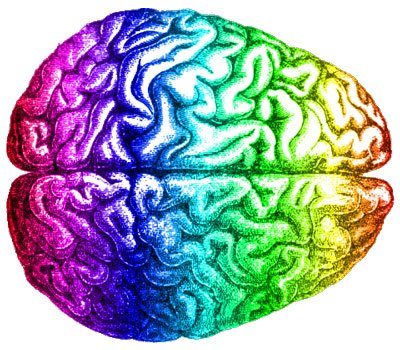
Chromosomes are so passé. Introducing: chromobrains!
Source: Muffinator, modified
Curtain open
In 1992, Time magazine published an article in which it was suggested that a brain difference in males vs females "might explain enigmatic phenomena like female intuition, which is supposed to accord women greater ability to read emotional clues"[1].
Rather than pooh-pooh the female writer of this article and accuse her of internalized chauvinism, let's see what the scientific literature has to say on this subject: are female brains really different from male brains?
Note: this will take more than 1 blog post to cover; and I'm not even going to delve deep into cognitive differences, which I'll leave for the future. For now, what I'm still concerned with is examining John Money's 8 criteria for determining the sex of a person. One, two, and three were chromosomes, gonads, and hormones. Four and five will be brains and...
A brief note on genitals
(because who doesn't love genitals?)

Ancient genitals. Our sturdy ancestors literally had balls of stone.
Source: Zde, modified
By ~ the 4th month of gestation, the development of the human genitalia is completed, and it's irreversible.[2, p. 15] (Sorry trans people.)
Genitalia is interesting, because it's the one thing every one of us — in our more innocent, less erudite, years — would think would settle the question of a person's sex with Supreme Court finality.
If it's not already evident from the earlier 2 posts of this series that that is not the case ... well, you've been a poor reader! Let's just say there are Olympic Committees that would looove to hire you if you think you possess a fail-safe method of telling a person's sex by their genitals.
Moving on to brains.
From gens to (animal) brains
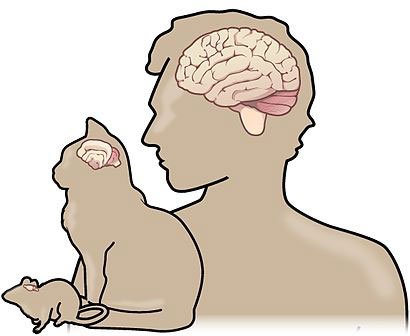
Source: CNX OpenStax, modified
When hormones are not busy developing genitals, they develop brains. (Actually, they do both at the same time. And many other things.)
The study of human sex differences in the brain is necessarily constrained by the lack of technology that can pry into the human infant's brain, and also mothers who, strangely, do not want their miscarried children autopsied and dissected.[2, p. 16]
For this reason, most research on this topic has been on other mammals, who do not have to give consent.
One of these areas of animal research is on how hormones affect behavior by influencing the development of the brain. In other words: hormones → brain → behavior. If you were to conduct this experiment, you'd find it relatively easy to inject an animal with hormones, and then see if this affects their behavior. (Hormones → behavior.) But how do you know the hormones affect the behavior through the intermediary of brains?
Well, it kinda stands to reason, doesn't it? But it doesn't hurt making sure. And so here's how you might go about making sure: Similar to the way in which doctors check for the presence of cancer by administering the patient with a drug that gets absorbed only, or preferentially, by cancer cells, and then using some machine (like a CT scanner) to detect the drug, and therefore the cancer activity; similarly, researchers give animals androgen hormones or estrogen hormones that are labelled in some way, and then detect where they are absorbed in the brain.
Research on mammals shows that some areas of the brain absorb more androgens than estrogens, and vice versa, indicating that some neurons are more sensitive to male hormones and others prefer female hormones.[3]
Food for thought: If the brain does not respond the same to the hormones of the two sexes, and if the two sexes produce different hormones, why would we expect the brains of the two sexes to be the same? Why do some neurons specifically have androgen hormone receptors, unless the brains of the two sexes were designed (blindly, of course) to be dissimilar?
So that's the hormones → brains part of the picture. How about the brains → behavior part?
Hormones turn out to influence a range of stereotypical sex behaviors:
[S]ome animal behaviors are facilitated (that is, activated) by gonadal hormones. Among these hormone-dependent behaviors are ones related to mating as well as courtship and defense of territory, including vocalization."[3]
Did I read vocalization? As in singing?
Brains made for song

Source: lukasbieri
There are androphilic (=androgen [=male hormone] loving) neurons in the songbird brain, in an area of the brain having to do with vocalization. Vocalization is a behavior in male songbirds that is androgen-sensitive.
But it's not just hormones affecting the brain affecting behavior: hormones or not, the morphology of the brain itself differs from male to female:
we know that the female brain differs morphologically from the male brain in that certain cell groupings within the song system are smaller in females than in males [...]. Such morphological differences suggest that an insufficiency of cells or synaptic connections in the female brain might be at least a partial explanation for sex differences in singing ability independent of the activating action of the hormones[3]
But let's go back to mammals, in case you think birds are too different from you and I (you speciesist!)
Just to give one of many examples: in what are called "implantation studies", experiments with rats that were implanted with hormones showed they can affect the rats' sexual mood.
These observations established that stimulation of the VMH [ventromedial hypothalamus] alone is sufficient for activation of feminine sexual receptivity.[3]
If you haven't brushed up on your Darwin in a long time, I should remind you that these animals are our relatives. What are the chances that hormones affect their brains in sex-specific ways, but not ours? Here's a partial list of the animals in which hormones preferentially affect brain regions: amphibian (Xenopus laevis), reptile (Anolis carolinensis), zebra finch (Poephila guttata) ... ah, let's drop the Latin: bird, rat, guinea pig, monkey, ferret, prairie vole, sheep, dog, hamster, red deer stag, frog...
The chances therefore would seem high that similar sex differences exist in us, and that complexity and/or ethics and/or insufficient technology makes them harder to find.
Note that the differences might be there, but may not necessarily be the same differences. Our basic brain plan might be the same, but some patterns are species-specific:
Although a basic plan of gonadal steroid-sensitive neural systems is recognizable across vertebrate classes [...], there are also examples of species-specific patterns of steroid-sensitive neurons which are superimposed on the basic plan.[3]
This accounts for the remarkable diversity observed in sexual differences across species. For example, an area in which there is diversity among species is bisexuality of males vs females. (I know, I pick all the great topics.) This appears to happen because masculinization and defeminization differs among species:
Masculinization is defined as the enhancement during development of masculine traits; defeminization is the suppression in development of feminine traits, especially those that are normally activated in adult life by estrogens and progestins. In rats, females undergo some degree of masculinization and are more bisexual than males, whereas males are extensively defeminized. In rhesus monkeys, males do not undergo defeminization, but are masculinized and become more bisexual than females.[3]
Overall, the conclusion that can reasonably be drawn from the study of sex differences in animals is the following:
It seems reasonable that the neural substrate for gonadal steroid responsiveness is represented in the human brain in much the same way that we know it to be represented in the brains of the rhesus monkey and bonnet monkey-with a basic plan like that of other vertebrates but with unique features of hormone response[3]
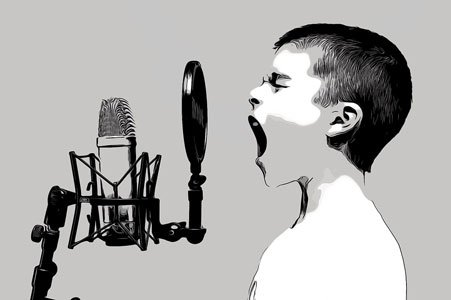
Source: TENLEAF
I don't want you to leave this section with a too-literal interpretation of some of the above examples. For instance, just because songbirds have areas of their brains relating to song, doesn't mean that... oh, wait, it does?
Turns out, there is a portion of the corpus callosum (a part of the brain that enables communication between the two brain hemispheres) that is "significantly larger in musicians than nonmusicians".[4]
Bear in mind, this is not as a result of hormones, nor does it happen in the mother's womb. It's a result of musical training prior to age 7.[5] I'm just mentioning it because it's a nice thing to know, esp. if you intend your children to study music at some point (in which case it's better earlier than later), and because I know a couple things about this corpus callosum.
Reason I know these couple things, is because (a) it's been an area of extensive research looking for sex differences, (b) it's what the Times Magazine quote in the introduction of this post refers to, and (c) it's been highly controversial.
So let's now turn our attention to this tough nut, and see if we can crack it.
Tough body
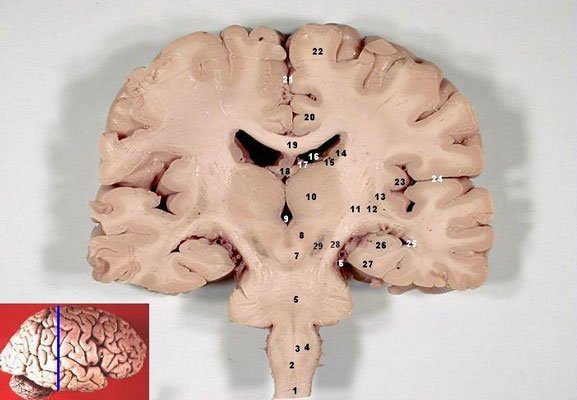_section_description_2-.jpg)
The corpus callosum (CC) is that thing there numbered 19 that looks like a brain boomerang.
Source: John A Beal, PhD Dep't. of Cellular Biology & Anatomy, Louisiana State University Health Sciences Center Shreveport
The corpus callosum (Latin for "tough body") is a bundle of trans-hemispheral fibers that enable communication between the right and left cerebral hemispheres.[4] It caught the attention of sex differences researchers more than a hundred years ago, when it was suggested that its size differed between men and women. Now who would go and suggest a thing like that?
It was Mr. Bean that did it. Not that Mr. Bean, silly you. It was one R. B. Bean, an anatomist. He wrote, in 1906, that "exceptional size of the corpus callosum may mean exceptional intellectual activity", and that there were differences in its size between men and women. Later, he said differences could also be found between the races.[4]
And that was enough for most academia to henceforth ignore him, until the subject was resurrected by more modern research. Research that, to Bean's chagrin, showed the corpus callosum to be larger, not smaller, in females compared to males, even controlling for overall brain size.
And they didn't only begin with greater size:
[A]nterior regions in the callosa of women continued to increase in size even through the 5th decade, whereas male anterior callosal measures appeared to peak in the 2nd to 3rd decades and decline in size thereafter[6]
Talk about rubbing salt in Bean's wound.
Let's remove some:
evidence suggests that the anterior CC in women declines in width to the size seen in men by the 7th decade of life[6]
There, by the time we're all 70, our CCs are completely equal!
Oh, let's throw a Bean-dog a bone:
age-related decreases in volume in the human brain are greater in men than in women in the frontal and temporal cortices [...], whereas in the parietal cortex and hippocampus, decrements are greater in women than in men[6]
In other words: brain differences exist between the sexes. Some things are larger in women; some things are larger in men. It's like breasts and external genitalia.
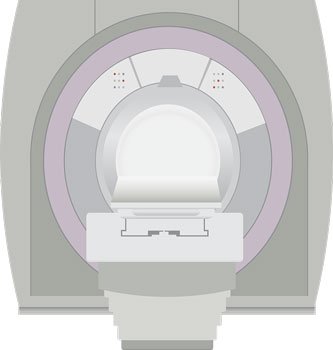
Either a toilet, or an MRI machine. Can't tell from this angle.
Source: LJNovaScotia
As techniques became more Professor-Xavier-ish, scientists were able to MRI-pry into the heads of 100 female and 100 male volunteers aged 16-65. The wide age gap served to settle a possibility raised by earlier studies: that maybe the CCs of males and females differed at the gestational stage, but later normalized, or else continued to widen. As one study put it, "We are not, however, excluding the possibility that a differential post-natal environment may further sculpt the corpus callosum."[7] In other (simpler) words, they didn't know what happens after birth. (I thought the big mystery was what happens after death, but leave it to science to fully confront you with your ignorance.)
The MRI study found a significant sex difference in the brain of humans:
The significant finding of sex differences in midsagittal surface area relative to cranial volume is a striking result.[8]
It was striking because earlier studies, taken altogether, had yielded mixed results, some showing sex differences and some not. Did the MRI study put an end to the controversy? You bet not!
Later metastudies came to challenge these results. One stated that "[a] meta-analysis of 49 studies published since 1980 reveals no significant sex difference in the size or shape of the splenium of the corpus callosum" and that therefore "[t]he widespread belief that women have a larger splenium than men and consequently think differently is untenable."[9]
Untenable my buttocks!

Snoozing gorilla (with buttocks).
Source: JakeWilliamHeckey
Let's consider a newer study, 2013 as opposed to the earlier study's ancient 1997. (It's only ancient when it's wrong. Otherwise it's prescient.)
Besides explaining, in quasi-metastudy fashion, the reasons why some of the studies in the past may have yielded opposite results (I won't go into it, but it has to do with methodology, both experimental and statistical), the newer study also did new research on a whopping 316 brains (18-94 years old) publicly available (not as real brains, but as scans) through the OASIS Brain Database. You might not think 316 deserves the adjective whopping, but "[o]ur sample size of 316 is the largest sample size used to date for addressing gender differences in CC size."[10]
The result? "[T]he average CCA [corpus callosum cross-sectional area] was significantly [...] larger in females."[10]
The study also refuted a common argument (which, again, I won't go into) that was used by "no difference" proponents to explain away the results of studies that showed "yay difference".
Most new studies I've read the abstracts of (unless I indicate otherwise, I read all papers I cite from head to toenail) side with the above:
Our results demonstrate significant morphologic differences in the corpus callosum between genders and a possible sex difference in the neuro-developmental cycle.[11]
And:
A robust sex difference in the splenium of the corpus callosum, reflecting greater interhemispheric connectivity in women, was observed on magnetic resonance images from 114 individuals.[12]
And so on. You get the point.
Still, this is considered a "long-standing and often contentious debate in the scientific community"[10], so feel free to explore further, perhaps by starting from here. It's my studied opinion though that there are indeed average differences in the corpora callosa of women and men.
But it doesn't even matter, given that everyone in the field agrees that brain differences exist in other parts of the brain. We'll visit these in the next part of this post and series.
From animal (brains) to human (brains)

Poligraf Poligrafovich Sharikov.
Source: Smallbones at en.wikipedia
My readers always complain about how short my posts are. (Well, you don't audibly complain, but I know you're thinking it.) So I thought I'd add one more section before wrapping up.
Before taking that whole "corpus callosum" detour, I was talking about hormones' roles in animal brains and behaviors.
Here's a snippet from another paper to remind you of our conclusion, in case you have the memory of a goldfish:
"It has been clearly documented in animals that early exposure to masculinizing hormones causes masculinization of neuroanatomy, physiology, and behavior"[13]
When they say behavior, they're talking about things like "play behavior in rhesus monkeys" and "spatial ability in rodents".[13]
What's true of some of our closest relatives, may be true for us too, I concluded.
And I stopped there, citing the difficulties of doing this type of research in humans.
One of the reasons it's been difficult to experiment in humans is something to do with ethics committees. These party poopers always nag on about how "this is immoral" and "that is unethical" and "have you lost your effing mind?"
Thankfully (?), Nature isn't quite so morally "qualmy" as humans (seeing as she takes orders directly from God, who is not famous for his moral scruples), so she has provided us with experiments herself. For example, women born with congenital adrenal hyperplasia, in which the fetus is exposed to very high levels of androgens, are "often masculinized for a number of behaviors".[13] (So, next time you're wondering about the reasons behind male vs female behavior, don't exclude hormones.)
Another way in which intrauterine (=within the womb) humans can be studied is when they're dead. One study for instance looked at the cerebra of "infants who spontaneously aborted or died shortly after birth".[7] A few of them were from "induced abortions".
"Who collects the cerebra of dead fetuses?", you may ask. It's the guys over at the Yakovlev collection, and not only do they collect brains, they slice them up too (clic for pic). I bet they'd make a good ingredient in a sandwich. But I digress.
The point is, I wanted to close this post by saying that some research can be done on humans too, and the results are concordant with the ones from other mammals:
[O]ur data provide further indirect evidence that the gonadal steroids and/or genetic sex play a role in the development of neural structures, linked with "cognitive functions", in the human brain.[7]
Curtain close

Sometimes the sexes differ dramatically.
Source: © Francis C. Franklin / CC-BY-SA-3.0
The writer of the Time magazine article with which I opened, may have exaggerated science's reach when she suggested that what we know about brain differences might explain female intuition.
But in the main she was right: brain differences do exist.
And though I chose a quote that might appear rather silly out of context (I was imitating what wikipedia did here), if you read the whole article it's quite grounded and measured, and doesn't really make unwarranted claims, in all.
Join me next time when I'll be (hopefully) wrapping up this foray into brain differences. I'll be talking about differences that exist rather unquestionably, and will be examining some of the hypotheses concerning their evolutionary origin.
REFERENCES
1. Gorman, Christine "Sizing up the sexes". TIME 1992 January 20; 139(3): 42-48. https://studfiles.net/preview/4533353/page:7/
2. Mealey, L. (2000). Sex differences: Developmental and evolutionary strategies. Academic Press.
3. McEwen, B. S. Neural gonadal steroid actions. Science 20 Mar 1981: Vol. 211, Issue 4488, pp. 1303-1311
DOI: 10.1126/science.6259728 http://science.sciencemag.org/content/211/4488/1303.long
4. Wikipedia contributors, "Corpus callosum," Wikipedia, The Free Encyclopedia, https://en.wikipedia.org/w/index.php?title=Corpus_callosum&oldid=830230323 (accessed March 29, 2018).
5. Christopher J. Steele, Jennifer A. Bailey, Robert J. Zatorre and Virginia B. Penhune
Journal of Neuroscience 16 January 2013, 33 (3) 1282-1290; DOI: https://doi.org/10.1523/JNEUROSCI.3578-12.2013
6. Roslyn Holly Fitch, Patricia E. Cowell & Victor H. Denenberg (2009) The female phenotype: Nature's default?, Developmental Neuropsychology, 14:2-3, 213-231, DOI: https://doi.org/10.1080/87565649809540710
7. de Lacoste MC, Holloway RL, Woodward DJ. Sex differences in the fetal human corpus callosum. Human neurobiology 5(2):93-6. February 1986. PMID: 3733479. https://www.researchgate.net/publication/19427415_Sex_difference_in_the_fetal_human_corpus_callosum
8. Sterling C. Johnson, Tamra Farnworth, James B. Pinkston, Erin D.Bigler, Duane D. Blatter. Corpus callosum surface area across the human adult life span: Effect of age and gender Brain Research Bulletin Volume 35, Issue 4, 1994, Pages 373-377. https://doi.org/10.1016/0361-9230(94)90116-3
9. Katherine M. Bishop, Douglas Wahlsten. Sex Differences in the Human Corpus Callosum: Myth or Reality? Neuroscience & Biobehavioral Reviews Volume 21, Issue 5, 1997, Pages 581-601. https://doi.org/10.1016/S0149-7634(96)00049-8
10. Babak A. Ardekani, Khadija Figarsky, John J. Sidtis; Sexual Dimorphism in the Human Corpus Callosum: An MRI Study Using the OASIS Brain Database, Cerebral Cortex, Volume 23, Issue 10, 1 October 2013, Pages 2514–2520, https://doi.org/10.1093/cercor/bhs253
11. Abraham Dubb, Ruben Gur, Brian Avants, James Gee. Characterization of sexual dimorphism in the human corpus callosum. NeuroImage Volume 20, Issue 1, September 2003, Pages 512-519. https://doi.org/10.1016/S1053-8119(03)00313-6
12. C Davatzikos, S M Resnick; Sex differences in anatomic measures of interhemispheric connectivity: correlations with cognition in women but not men., Cerebral Cortex, Volume 8, Issue 7, 1 October 1998, Pages 635–640, https://doi.org/10.1093/cercor/8.7.635
13. Grimshaw, G. M., Bryden, M. P., & Finegan, J.-A. K. (1995). Relations between prenatal testosterone and cerebral lateralization in children. Neuropsychology, 9(1), 68-79. http://dx.doi.org/10.1037/0894-4105.9.1.68
Earlier Sex Differences episodes:
2: Sex Differences: Check out the gonads on that one!
1: Sex Differences: Does the Chromosome Maketh the Man?
steemSTEM is the go-to place for science on Steemit. Check it out at @steemstem or browse the #steemSTEM tag or chat live on discord
